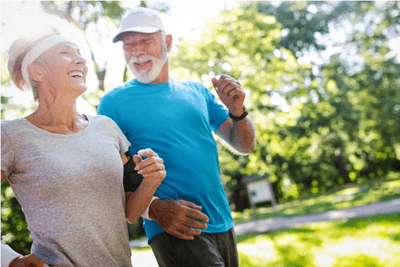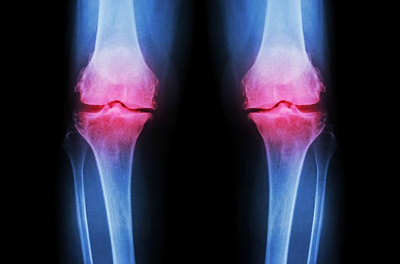“Exercise is proven to be an effective treatment for osteoarthritis”

So for the past couple of weeks, you’ve had some knee or hip pain. You thought maybe it was from that long walk you did with your friend a couple of weekends ago and that it would go away. But as the days pass, it seems to be sticking around. You’ve noticed that in the mornings your knee or hip feels stiff and takes a while to loosen up. You decide you should go to the doctor.
After going for x-rays, you are sitting and waiting for the doctor to tell you what is going on. Then the doctor tells you. You have osteoarthritis. Osteoarthritis?! What is that? Your doctor is explaining it to you and you hear words like degeneration, aging, bone on bone. Now you are in a cold sweat.
What you thought was just some aches and pains sound like it’s a lot more serious. You think about your 85-year-old uncle who has arthritis in both his knees and uses a four-wheeled walker. You think, “Oh no! “I’m too young for a four-wheeled walker and how will I lift that thing up all those stairs in my house?!”. You then think about your friend’s niece who had to get a hip replacement last year. Surgery!? Now you really are freaking out. You think to yourself, “I can’t let this get worse”. Perhaps, you start to conclude, “I have to be careful and stop walking so much”. No more taking the stairs at work, I’ll always take the elevator. If I rest my knee or hip, it will get better and I can avoid surgery right?? Wrong! Exercise is proven to be an effective treatment for osteoarthritis.
What is Osteoarthritis?
Let’s rewind a bit and first talk about what osteoarthritis actually is. Osteoarthritis can occur in any joint but is most common in the hip, knee, low back, neck, and fingers. It typically occurs in adults over the age of 45. With osteoarthritis, the cartilage in our joint is affected and can start to thin out. Cartilage is a tissue in our joints that cushions the joint and helps absorb stress. When the cartilage starts to thin out, the joint space starts to get smaller. In severe osteoarthritis, the cartilage can become thin enough and the joint space small enough, that surgery may be the only option to improve your pain and outcome. But that does not mean that everyone needs surgery. Cartilage breakdown happens in everyone as we get older. With osteoarthritis, it tends to be a bit more severe. Not everyone who shows signs of osteoarthritis on an x-ray will have pain. Many people with osteoarthritis will have no symptoms at all. That is important as it lets us know that the pain and symptoms associated with osteoarthritis are modifiable and we don’t always need surgery to do it.

Treatment Options
“Keep moving and exercising! It’s the best thing you can do for your osteoarthritis and your body”
Exercise
One of the best things you can do for your osteoarthritis is exercise! Exercise improves strength, fitness, mood, and mental health, and can decrease inflammation. Inflammation is a part of osteoarthritis and can lead to further damage to the cartilage. When we exercise, we increase natural anti-inflammatory chemicals in our bodies that help fight this inflammation. By improving our strength, particularly of the muscles surrounding the affected joint, the muscles will provide better support of our joints and decrease some of the stress and strain on the joint itself. Not only does exercise improve our osteoarthritis but it will also help prevent other diseases such as heart disease and diabetes. You may have heard from someone that osteoarthritis is caused by too much wear and tear on your joints such as walking or running. But this is not the case. Running and walking can be preventive of osteoarthritis. The long and short of it is, don’t sit! Keep moving and exercising! It’s the best thing you can do for your osteoarthritis and your body.
Types of Exercise
Now, hopefully I’ve convinced you exercise will help with your osteoarthritis. At this point, you may be thinking, what kind of exercise is best? In general, we want to be doing something that includes strengthening, balance exercises and aerobic exercise such as walking, swimming or biking. If you’re not sure what exercise to do or are someone who hasn’t exercised much in the past, that’s OK! That’s what physiotherapists are for. We are here to help you create a successful exercise program to help you manage your pain and symptoms and get you back doing what you do best, whatever that may be.
Nicole Soderberg
Physiotherapist at Pivotal Physiotherapy
Ask me a question
Book an appointment with Nicole
Victor Valderrabano, Christina Steiger, “Treatment and Prevention of Osteoarthritis through Exercise and Sports”, Journal of Aging Research, vol. 2011, Article ID 374653, 6 pages, 2011.https://doi.org/10.4061/2011/374653
Davis, A.M., Davis, K.D., Skou, S.T. et al. Why Is Exercise Effective in Reducing Pain in People with Osteoarthritis?. Curr Treat Options in Rheum 6, 146–159 (2020). https://doi.org/10.1007/s40674-020-00154-x
Di Lorito C, Long A, Byrne A, et al. Exercise interventions for older adults: a systematic review of meta-analyses. J Sport Health Sci 2021;10:2947.
